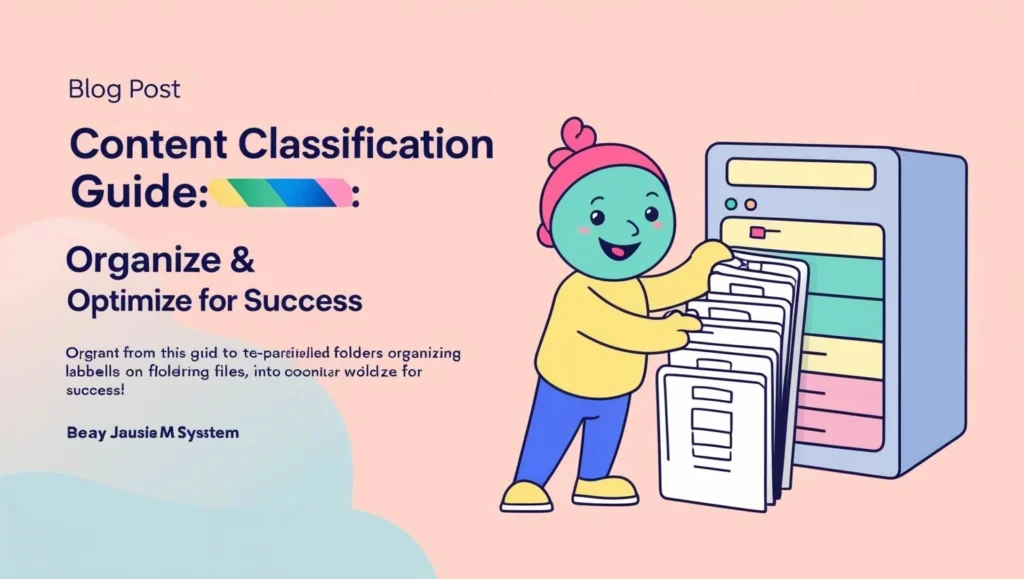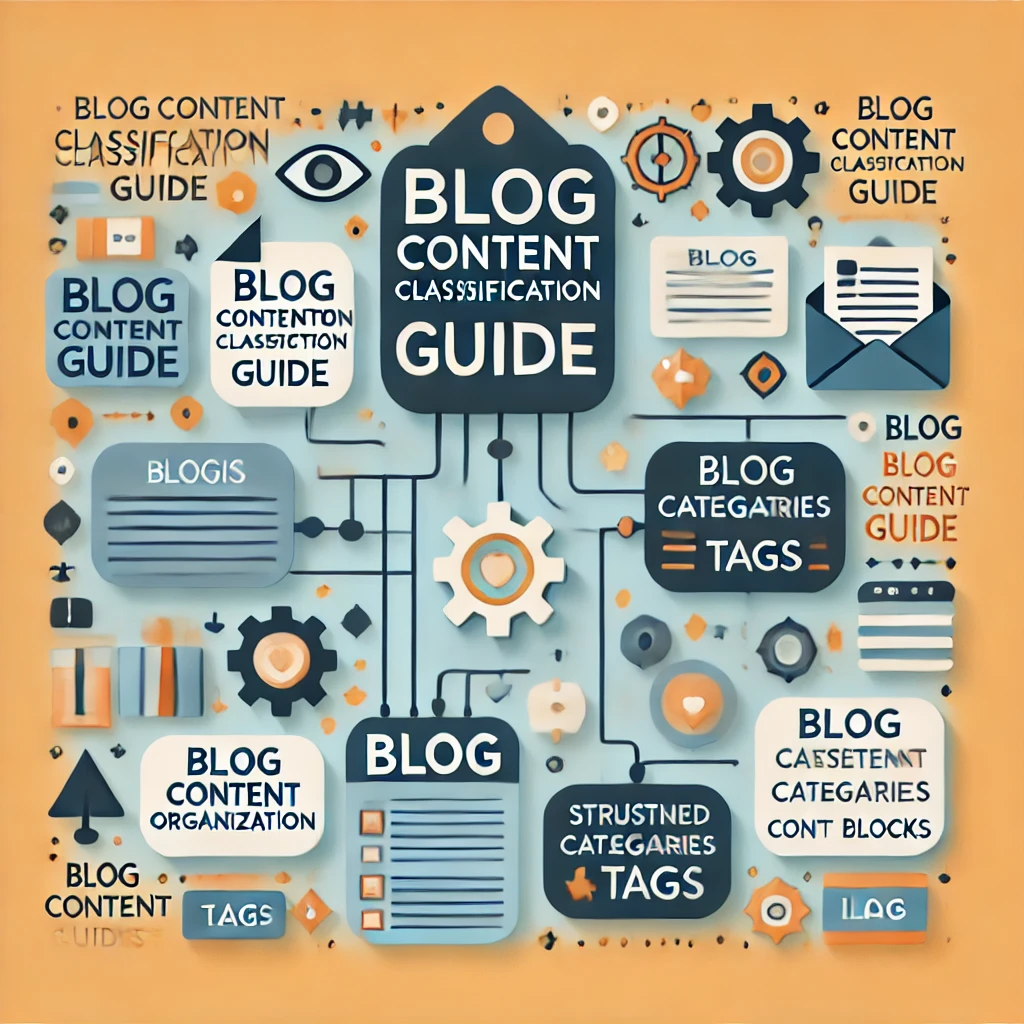Are you struggling to keep your blog content organized? A cluttered blog makes it difficult for readers to find relevant posts and can hurt your SEO rankings. That’s why having a blog content classification guide is very important.
Before diving into structuring your blog, it’s important to start with the right foundation. If you’re just getting started, check out this blog 7 Key Factors to Consider Before Starting a Blog to set yourself up for success.

Classifying your content properly improves user experience, boosts search engine visibility, and helps you develop a well-structured content strategy. In this guide, we’ll walk you through the best ways to organize your blog effectively so your audience can easily find the content they need.
- 1. Categorizing Your Blog Content Effectively
- 2. Using Tags for Detailed Content Classification
- 3. Classifying Content by Format and Type
- 4. Organizing Content Based on the Buyer’s Journey
- 5. Implementing a Pillar & Cluster Strategy for SEO
- 6. Optimizing Internal Links for Better Navigation
- 7. Maintaining a Consistent Blog Classification System
Why Blog Content Classification Matters?
A well-structured blog isn’t just about aesthetics—it plays a key role in your blog’s success. Here’s why every blogger needs a solid blog content classification guide:
- Better User Experience : Readers can quickly locate topics of interest.
- SEO Optimization : Search engines rank well-organized blogs higher.
- Improved Content Strategy : Helps identify content gaps and future topics.
- Higher Engagement & Retention : Keeps visitors on your site longer.
Now, let’s explore the best ways to categorize and structure your blog for success.
1. Categorizing Your Blog Content Effectively
Categories are the foundation of any blog content classification guide. They provide broad topic groupings that make it easier for readers to navigate your blog.
Here’s How to Define Strong Blog Categories
Your categories should be broad enough to cover various subtopics but specific enough to give clear direction. A good rule of thumb is to limit your categories to 5–10 key themes that align with your niche.
For example, a digital marketing blog might use categories like:
- SEO Strategies
- Content Marketing
- Social Media Trends
- Email Marketing
- Advertising & Paid Media
Once you’ve defined your categories, ensure that every new post fits neatly into one of them. This keeps your blog structured and easy to explore.
2. Using Tags for Detailed Content Classification

While categories group broad topics, tags help classify blog posts at a more granular level. They allow you to link related posts across different categories, enhancing navigation.
here are some best Practices for Blog Tags
- Keep tags specific but relevant (e.g., “Google Algorithm Update” rather than “SEO”).
- Use 5–10 tags per post to avoid clutter.
- Ensure tags are consistent to prevent duplicates and confusion.
For example, a blog post about recent SEO updates might have tags like:
- “SEO 2024”
- “Google Algorithm Update”
- “Keyword Research”
- “On-Page SEO”
By using well-thought-out tags, your blog becomes easier to search and explore.
3. Classifying Content by Format and Type
Another essential step in your blog content classification guide is categorizing posts by format. Readers have different preferences when consuming content, so organizing by type helps them find what they’re looking for.
Common Blog Content Types
- How-To Guides : Step-by-step tutorials and instructional posts.
- Listicles : Numbered lists offering quick insights (e.g., “10 Best SEO Tools”).
- Case Studies : Real-world examples showcasing results.
- Opinion Pieces : Thought leadership content sharing personal insights.
- News & Updates : Industry trends and breaking news.
By labeling your blog posts by type, readers can quickly identify the content that suits their needs.
4. Organizing Content Based on the Buyer’s Journey
If you run a business blog, structuring content based on the buyer’s journey is a game-changer. It ensures you’re serving the right content to the right audience at the right time.
Examples of Stages of the Buyer’s Journey & Blog Content
- Awareness Stage : Educational content that introduces a problem (e.g., “What Is SEO and Why Does It Matter?”).
- Consideration Stage : Content comparing solutions (e.g., “SEO vs. PPC: Which Strategy Is Best?”).
- Decision Stage : Case studies, testimonials, and product reviews that help readers make a final choice.
Classifying content this way ensures that each visitor finds content that resonates with their needs, improving conversion rates.
5. Implementing a Pillar & Cluster Strategy for SEO
A blog content classification guide isn’t complete without a strong internal linking structure. The pillar-cluster model is an excellent way to improve SEO and organize content.
How the Pillar-Cluster Model Works?
- Pillar Content: A comprehensive, high-level guide covering a broad topic (e.g., “The Ultimate Blog Content Classification Guide”).
- Cluster Content: Related articles that dive deeper into subtopics and link back to the pillar post (e.g., “How to Choose the Right Blog Categories”).
This method strengthens internal linking, helps search engines understand your site structure, and improves keyword rankings.
6. Optimizing Internal Links for Better Navigation
A well-organized blog should have an effective internal linking strategy. This keeps readers engaged and helps search engines crawl your site more efficiently.
Best Practices for Internal Linking
- Link to related posts within your content.
- Use descriptive anchor text rather than generic phrases like “click here.”
- Avoid excessive linking, as it can overwhelm readers.
By thoughtfully interlinking your posts, you create a seamless reading experience while boosting your blog’s SEO.
7. Maintaining a Consistent Blog Classification System
Creating a blog content classification guide is just the first step—you also need to maintain it over time. Without regular updates, your blog can easily become disorganized again.
Tips for Long-Term Blog Organization :
- Conduct content audits regularly to refine categories and tags.
- Keep your taxonomy simple and intuitive for both readers and search engines.
- Use analytics to track which content categories perform best.
By consistently managing your blog structure, you ensure that your content remains easy to navigate, search-friendly, and valuable to readers.
A well-organized blog is the key to better user experience, stronger SEO, and a more effective content strategy. By following this blog content classification guide, you can create a structured, easy-to-navigate blog that keeps readers engaged and ranks well on search engines.
Start by defining your categories, refining your tags, and implementing internal linking strategies. Over time, these small adjustments will have a huge impact on your blog’s performance.
Ready to optimize your blog? I hope this guide helps you to audit and refine your content classification system




